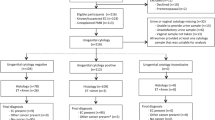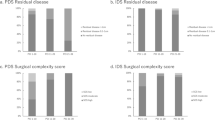Abstract
Recent evidence indicates that the distal fallopian tube is the principal site of early serous cancer in women with a hereditary risk for ovarian cancer. Moreover, the fimbria is involved by early cancer in a significant minority of pelvic serous carcinomas, irrespective of whether the patient has a hereditary BRCA1 or BRCA2 mutation. In addition, the distal tube has been identified occasionally as a site of concurrent endometrioid tumors in women with endometrial carcinoma. Although the risk of sporadic fimbrial tumors in otherwise healthy women without genetic risk is unknown, routine histological examination of the fimbria provides the opportunity to determine the risk of such an event. To illustrate this point, a case of a woman who underwent surgery for an ovarian fibroma is presented. The distal tube was submitted, and found to harbor a focus of serous tubal intraepithelial carcinoma (STIC) with a 2-mm invasive tumor. Incidentally discovered carcinomas underscore the potential risk, albeit low, of concurrent unsuspected malignancy in the distal fallopian tube and emphasize the importance of routine pathological examination of the fimbria in all salpingectomies. The rationale for this strategy, and its potential effect on early detection and in uncovering persons or families potentially at risk for ovarian cancer, is discussed.
Similar content being viewed by others

Main
Routine pathological examination of the uterus and adnexae entails sampling of the cervix, endomyometrium, fallopian tubes and ovaries, ostensibly to confirm the presence of these tissues and to exclude incidental disease, specifically neoplasia. The cervix is routinely submitted to show the cervical transformation zone, inasmuch as this is the site of origin of HPV-related squamous and glandular neoplasia. Similarly, sections of anterior and posterior endometrium are examined to exclude an occult neoplasia (endometrial intraepithelial neoplasia and/or adenocarcinoma), which although rare, will be encountered periodically in a presumably normal uterus. Leiomyomata are sampled, albeit variably, primarily to exclude a grossly unappreciated leiomyosarcoma.
The ovaries and fallopian tubes are sectioned typically to document their presence, except in rare instances when neoplasia is discovered. In particular, the fallopian tubes have been given the most limited examination, often limited to a single cross-section in the center of the tube, or a cross-section combined with a fragment of the fimbriated end. Irrespective of the sampling strategy, invariably only a portion of the fallopian tube is submitted for histopathological analysis. However, this protocol changes in the woman with a BRCA1 or BRCA2 (BRCA+) mutation who is undergoing a risk-reducing surgery for the removal of the tubes and ovaries. In these specimens and in those from women with a family history of ovarian cancer, the entire tubes and ovaries are histologically submitted for a pathology review. Recent reports indicate that in BRCA+ women over the age of 40 years, the odds of discovering an early serous or endometrioid carcinoma are between 5 and 10 per 100 cases examined.
When an early serous carcinoma is detected in the fallopian tube, either in a woman with or without a family history, the majority are in the distal (fimbria) segment.1 Interestingly, occult endometrioid carcinomas of the fallopian tube associated with endometrial carcinomas are also typically fimbrial.2 Moreover, some common benign tumors, specifically adenofibromas, are unique to the fimbria relative to the more proximal tube.3 Thus, the distal fallopian tube has emerged as an important locale for early serous and endometrioid carcinomas in BRCA+ women, as well as in women undergoing surgery for ovarian cancers.4, 5, 6, 7
Although a close scrutiny of the distal tube will uncover tumors in women considered at high risk for pelvic serous carcinoma, specifically those who are BRCA+, the notion that the tube could harbor clinically occult neoplasia has not been addressed in a systematic manner. The low expectations on the part of pathologists for such an event are evident in the manner by which the fallopian tubes are processed in routine salpingo-oophorectomy specimens. However, one case recently observed in our consultation files calls to question this strategy and argues for a more detailed examination of the distal tube in routine practice.
Case report
A 69-year-old woman with a history of an earlier vaginal hysterectomy presented with complaints of bloating and alternating episodes of constipation followed by diarrhea. There were no other abnormal findings on her pre-operative evaluation. An abdominal ultrasound revealed a left adnexal mass. The patient underwent a bilateral salpingo-oophorectomy, which confirmed a left ovarian mass and no other pelvic abnormality.
The ovary contained a 7-cm smooth mass, which revealed a homogeneous tan surface on sectioning. Both the fallopian tubes and the right ovary appeared grossly unremarkable.
A pelvic washing at the time of surgery was negative. Sections of the ovary received in consultation revealed a left ovarian fibrothecoma. However, the primary pathologist submitted the fallopian tubes in their entirety according to the earlier described SEE-FIM (sectioning and entirely examining the fimbria) protocol.8 In one section of the fimbriated end of the left fallopian tube, a 2-mm invasive serous adenocarcinoma was discovered in association with a serous tubal intraepithelial carcinoma (STIC, Figure 1a and b). The latter was strongly positive with immunostains for MIB-1 and p53, staining more than 70% of the cell nuclei (Figure 1c and d). A portion of the STIC stained negative for p53 (Figure 1d, boxed area), consistent with a second truncating mutation in the p53 gene leading to a deletion of the antigenic target.
Early serous tubal carcinoma. At low magnification, (a) a small invasive carcinoma is observed, which is associated with a serous tubal intraepithelial carcinoma (b). Both are strongly Mib-1 (c) and p53 (d) positive. The absence of p53 staining in a portion of the STIC (boxed area in panel d) is consistent with a second p53 mutation leading to the loss of detectible p53 protein.
Discussion
The processing of a specific organ or specimen submitted for pathological evaluation is governed by the disorders that are unique to that organ. When confronted with a specific tumor, the pathologist follows a protocol appropriate to that neoplasm, which ensures the recovery of all clinically and biologically relevant information. In the case of an early cervical cancer, the entire cervix is submitted to determine the extent of the disease and to guide the subsequent management, and additional tissues (lymph nodes, etc.) are examined with this in mind. When a uterus and a cervix are submitted for benign disease (eg, leiomyomata) or for a non-cervical neoplasm (ie, endometrial carcinoma, etc.) the cervix examination is governed by (1) its gross appearance; (2) the odds that, if grossly negative, the cervix harbors clinically insignificant disease; and (3) the presumed location of disease, if it were to be unexpectedly encountered histologically at this site. As a rule, a normal-appearing cervix that has been received for reasons other than suspected cervical cancer or pre-cancer is not sectioned extensively because of the very low risk of unsuspected malignancy. If the cervix is grossly normal, a single histological section is taken from each of the anterior and posterior surfaces, including the squamo-columnar junction, corresponding to the geographic distribution and mucosal location of most cervical neoplasms. The expectation is that a neoplasm will not be found, but if one is present, this strategy maximizes the odds of detection.9
Presently, the Association of Directors of Anatomic and Surgical Pathology have recommended a two-tiered approach to the fallopian tube, depending on the level of suspicion for an occult invasive or intraepithelial carcinoma. The fallopian tubes removed for pelvic cancer risk reduction should be sampled extensively, with attention to the fimbria, similar to the SEE-FIM protocol proposed by Medeiros et al8 The fallopian tubes removed from low-risk women undergoing procedures for benign conditions are to be sectioned at ‘2- to 3-mm intervals and submit 3 sections to represent isthmus, ampulla and infundibulum/fimbria (1 block).’10 Other publications recommend a single central section from the fallopian tube.9
Although the inclusion of the fimbria in the tubal analysis is important, submission of the entire infundibulum and fimbria is recommended by these authors for the following reasons:
-
1
Like the cervical transformation zone, the fimbria is the most likely site of occult carcinoma of any type in the fallopian tube, and can be processed in a single tissue block.1
-
2
Early serous carcinomas (including STIC) are sufficiently small, and therefore might be missed by representative sampling.8
-
3
Detection of an early serous carcinoma potentially has important implications for early intervention.11
-
4
Detection of early serous carcinoma in the fallopian tube, particularly in a woman in the pre-menopausal stage, might, depending on family history, justify testing for BRCA1 or BRCA2 mutations, which if present, would permit a closer surveillance of, and risk assessment for, other neoplasia in the patient and in family members.12
The strongest theoretical argument for this sampling procedure is the emerging data that implicate the distal fallopian tube in the pathogenesis of a significant—albeit unknown—percentage of pelvic serous carcinomas in women with BRCA1 and BRCA2 mutations.4, 5 The current assessment of risk for familial cancer is predicated on a series of parameters that, as currently defined, will not invariably identify women at genetic risk until either they or their close family members, or both, have developed a breast or ovarian malignancy. If fimbrial examination uncovered even a small number of at-risk women in this category, and did so at no additional cost, the benefit-to-cost ratio would be extremely high. A second advantage of this strategy would be that, in a relatively short time, a realistic estimation of the frequency of fimbrial carcinoma in the low-risk population would be attainable.
The principal arguments against submitting the entire fimbria for routine examination in salpingectomies removed for benign disease include the following:
-
1
Tubal carcinoma is probably so rare that the extra effort devoted to fimbrial analysis is not cost-effective. This argument can be challenged on the premise that the examination of the cervix is routine and yields minimal information.
-
2
Detection of early tubal carcinomas is not clinically helpful, and could be harmful to the patient. There is some validity to this argument, particularly if the early carcinoma carries no increased risk of peritoneal spread; however, this is a possibility that can neither be confirmed nor excluded at this point in time. At the least, detection of an early cancer would prompt further evaluation of the peritoneal cavity, including pelvic washings, to exclude spread. Although the value of early intervention remains to be determined, this is the optimal point in the natural history of serous carcinoma to attempt a chemotherapeutic cure. This is the chief goal of studies devoted to early detection.
-
3
Increased scrutiny of the distal fallopian tube will result in frequent over-diagnosis of intraepithelial carcinoma by inexperienced or unsuspecting observers, resulting in unnecessary patient anxiety and possibly, in inappropriate treatment. To these authors, this possibility carries the greatest concern because the diagnosis of STIC is not made consistently across multiple observers (J Carlson and C Crum, unpublished). However, this issue is best handled by education and attention to criteria; it is not justified to ignore a region of the reproductive tract that carries a definite, albeit small, risk of malignant transformation.
The interruption of pelvic serous carcinoma in its earliest stages remains a paramount goal in the quest to reduce the number of deaths attributed to this disease. Prophylactic salpingo-oophorectomy reduces the risk of pelvic serous carcinoma in women with BRCA1 or BRCA2 mutations by ∼85%.13 Accordingly, salpingo-oophorectomy in low-risk women presumably has a significant effect on the frequency of subsequent pelvic cancer.14 The number of early cancers encountered in the fimbria in the latter group would be expected to be extremely low. Nevertheless, on the basis of the case presented in this report, a routine examination of the fimbria will occasionally uncover cases of early serous or endometrioid carcinoma, and a cost-effective strategy to determine the frequency of this phenomenon should be used. The fundamental principal of ovarian cancer death reduction is early detection. As early malignancies detected in these low-risk women accumulate, the proof of this principal will be tested and the value of the distal tube as a target for intercepting early serous carcinoma will come into sharper focus. Accordingly, our understanding of the natural history of Stage IA non-invasive tubal carcinomas will be enhanced.
References
Cass I, Holschneider C, Datta N, et al. BRCA-mutation-associated fallopian tube carcinoma: a distinct clinical phenotype? Obstet Gynecol 2005;106:1327–1334.
Culton LK, Deavers MT, Silva EG, et al. Endometrioid carcinoma simultaneously involving the uterus and the fallopian tube: a clinicopathologic study of 13 cases. Am J Surg Pathol 2006;30:844–849.
Bossuyt V, Medeiros F, Drapkin R, et al. Adenofibroma of the fimbria: a common entity that is indistinguishable from ovarian adenofibroma. Int J Gynecol Pathol 2008;27:390–397.
Finch A, Shaw P, Rosen B, et al. Clinical and pathologic findings of prophylactic salpingo-oophorectomies in 159 BRCA1 and BRCA2 carriers. Gynecol Oncol 2006;100:58–64.
Callahan MJ, Crum CP, Medeiros F, et al. Primary fallopian tube malignancies in BRCA-positive women undergoing surgery for ovarian cancer risk reduction. J Clin Oncol 2007;25:3985–3990.
Kindelberger DW, Lee Y, Miron A, et al. Intraepithelial carcinoma of the fimbria and pelvic serous carcinoma: evidence for a causal relationship. Am J Surg Pathol 2007;31:161–169.
Carlson JW, Miron A, Jarboe EA, et al. Serous tubal intraepithelial carcinoma: its potential role in primary peritoneal serous carcinoma and serous cancer prevention. J Clin Oncol 2008;26:4160–4165.
Medeiros F, Muto MG, Lee Y, et al. The tubal fimbria is a preferred site for early adenocarcinoma in women with familial ovarian cancer syndrome. Am J Surg Pathol 2006;30:230–236.
Robboy SJ, Mutter GL, Shako-Levy R, et al. Cutup-gross description and processing of specimens, Chapter 35, In: Robboy SJ, Mutter GL, Prat J, Bentley RC, Russell P, Anderson MC (eds). Robboy's Pathology of the Female Reproductive Tract, 2nd edn. Churchille Livingstone: Oxford, 2009, pp 989–991.
Longacre TA, Oliva E, Soslow RA, Association of Directors of Anatomic and Surgical Pathology. Recommendations for the reporting of fallopian tube neoplasms. Hum Pathol 2007;38:1160–1163.
Nossov V, Amneus M, Su F, et al. The early detection of ovarian cancer: from traditional methods to proteomics. Can we really do better than serum CA-125? Am J Obstet Gynecol 2008;199:215–223.
Maehle L, Apold J, Paulsen T, et al. High risk for ovarian cancer in a prospective series is restricted to BRCA1/2 mutation carriers. Clin Cancer Res 2008;14:7569–7573.
Olopade OI, Artioli G . Efficacy of risk-reducing salpingo-oophorectomy in women with BRCA-1 and BRCA-2 mutations. Breast J 2004;10 (Suppl 1):S5–S9.
Modugno F, Ness RB, Allen GO, et al. Oral contraceptive use, reproductive history, and risk of epithelial ovarian cancer in women with and without endometriosis. Am J Obstet Gynecol 2004;191:733–740.
Acknowledgements
This work was supported by Grants from the NCI (P50 CA105009 [SPORE]: D Cramer, PI), NCI 1R21CA124688-01A1 (CP Crum, PI), the Francis Ward Paine and TSA Pemberton Funds from the Division of Women's and Perinatal Pathology, Brigham and Women's Hospital and a gift in memory of Elizabeth Ford Smith. The authors are grateful to Dr Catrina Reading for contributing this case and for her helpful discussions.
Author information
Authors and Affiliations
Corresponding author
Rights and permissions
About this article
Cite this article
Semmel, D., Folkins, A., Hirsch, M. et al. Intercepting early pelvic serous carcinoma by routine pathological examination of the fimbria. Mod Pathol 22, 985–988 (2009). https://doi.org/10.1038/modpathol.2009.64
Received:
Revised:
Accepted:
Published:
Issue Date:
DOI: https://doi.org/10.1038/modpathol.2009.64
Keywords
This article is cited by
-
IMP3 signatures of fallopian tube: a risk for pelvic serous cancers
Journal of Hematology & Oncology (2014)



